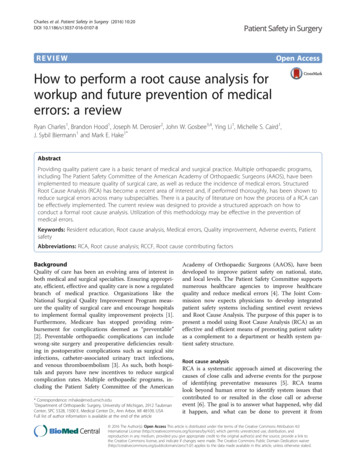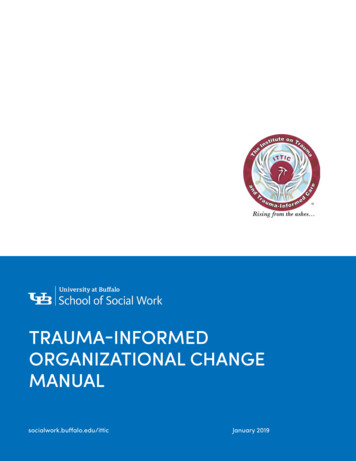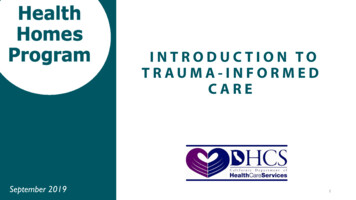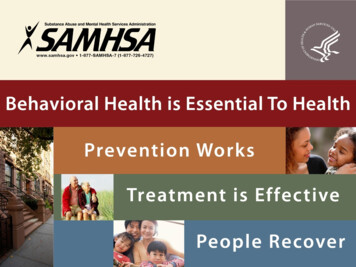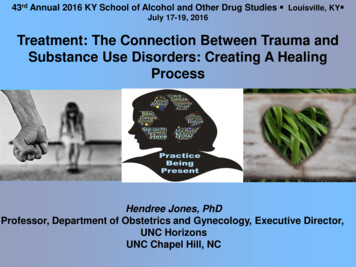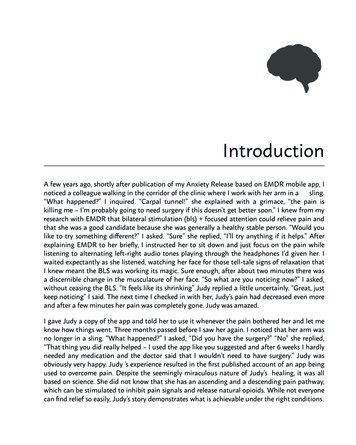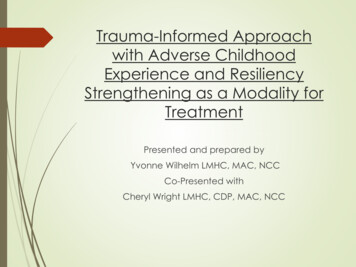
Transcription
Trauma-Informed Approachwith Adverse ChildhoodExperience and ResiliencyStrengthening as a Modality forTreatmentPresented and prepared byYvonne Wilhelm LMHC, MAC, NCCCo-Presented withCheryl Wright LMHC, CDP, MAC, NCC
Objectives: Understand Trauma-Informed Approach to Recovery Understand and articulate the relationship between Adverse ChildhoodExperience and adult health harming behaviors Learn the process for building resilience and the need for it in recovery
What is Trauma? Definition (SAMHSA 2014 TIP 52) – “traumaresults from an event, series of events, or setof circumstances that is experienced, by anindividual as physically or emotionallyharmful or threatening and that has lastingadverse effects on the individual’sfunctioning, and physical, social, emotionalor spiritual well-being
The Need for TraumaInformed Approach andTrauma-Specific Intervention Advice to counselors- The National Center for TraumaInformed Care: a comprehensive framework Realize the widespread impact of trauma Recognize the signs and symptoms of trauma in clients Respond by fully integrating treatments for substanceaddiction and mental health Resist re-traumatization Coordinate care for best treatment Trauma informed care for responders: Jane’s story
SAMHSA’s Six Key Principles to TraumaInformed Approach
Trauma and Addiction Unresolved Trauma- catalyst of substance abuse Trauma/Substance use cycle Research data Treatment Strategies
What is Trauma Informedcare?“Trauma informed care is an intervention andorganizational approach that focuses on how traumamay affect an individual’s life and his or her response tobehavioral health services from prevention thoughtreatment” (SAMHSATIP 52, pg 11 ) Begins with first contact Involves a commitment to building competence amongstaff, establishing programmatic standards and clinicalguidelines
What Makes an EventTraumatic?Traumatic Events are: Sudden, unexpected, and extreme Usually involve physical harm or perceived life threat(research shows the perception of “life threats” arepowerful predictors of the impact of trauma) People experience these events as out of their control Certain stages of life makes people vulnerable to theeffects of trauma including childhood, teens and early (Tedeschi, 2011)twenties. Developmental traumas, political and war, ACE,system oriented
Types of TraumaAcute trauma is a one-time traumatic event. Some examplesof acute trauma are: An auto accident A violent event in the community, such as ashooting A natural disaster such as a flood or a hurricane A sudden loss of someone the child cares about An assaultWhen a child experiences acute trauma, he or she mayexperience a range of emotions and physical reactions thatare quite overwhelming.
Types of Trauma (Cont’d)Chronic trauma occurs when a child or adult experiencemultiple traumatic events.These events may be varied in circumstances. Forexample a child may suffer ongoing sexual abuse, be avictim of physical assault at school, and then be involvedin a car accident each contributing to chronic trauma.Chronic trauma can have a cumulative effect.Subsequent traumatic events remind the child of priortrauma and can trigger emotions and thoughts related tothat prior trauma.
Types of Trauma (Cont’d)Complex trauma refers to the impact chronic trauma hason a child’s life and developing systems.A person who has complex trauma has experiencedmultiple traumatic events, often from early childhoodand this can have a profound impact on the child’sdevelopment and ability to function normally.
Bryce’s StoryWhat Kind of Trauma? “Hey, I’m Bryce and I’m 36 years old. I grew up living with my grandmabecause my mom’s boyfriend had been hitting her and then he got reallymad one day and hit me in the face and I couldn’t open my eye. I missedmy mom and was angry for a long time. My dad died when I was 5 fromdrugs.” I’ve been having nightmares so I try and drink myself to sleep. Myfriends describe me as “jumpy.” I admit I scare easily at loud noises.Sometimes I just want to be by myself and will not talk. Yet, if I hang outwith people and I have an anger outburst, I feel ashamed because itseems uncontrollable.Bryce has experienced multiple traumatic events (chronictrauma) such as the death of his father, witnessing familyviolence, physical abuse by his mother’s boyfriend, andseparation from his primary caregiver and these events arehaving an impact on Bryce’s functioning and sense of safety(complex trauma).
What does this mean for us asHealth Care Professionals?Building Trauma Informed Care Systems requires a Paradigm Shift fromthe Question:“What is wrong with you?” to “What happened to you?”A client’s behavior may be indicative of: Coping Mechanisms Survival Techniques ResiliencyEducation on Trauma-informed Care is critical :1. Is what I am doing respectful and trauma-informed?Understanding the Immediate and Delayed Reactions2. Am I treating others the way I want to be treated? Understandingthe Cognitive Triad of Traumatic Stress. Understanding theCognitions of TraumaOne of the most important things we can do as providers is avoid retraumatizing those we serve.
Long-Term Effects of TraumaWhen a traumatized person does not copewith trauma in a healthy manner, theperson may be prone to: Substance abuse Mental health issues (such as depressionand suicide) Promiscuity Criminal behavior
PTSD SymptomsPeople who have experienced multiple traumatic eventsare often diagnosed with Post Traumatic Stress Disorder(PTSD).Key symptoms of PTSD include: The person re-experiences the trauma (typicallythrough flashbacks and nightmares) The person will avoid stimuli associated with thetrauma The person may disengage from their emotions (maylose interest in things they used to like to do) The person may have physical symptoms for nomedical reason (stomach aches, headaches, etc.) The person may be more hyper vigilant (startle easily)
Prevalence of Trauma 90% of public mental health clients have beenexposed Most have multiple experiences of trauma 34-53% report childhood sexual or physical abuse 43-81% report some type of victimization
Prevalence of Trauma inSubstance Abuse Population Up to two-thirds of men and women in SA treatmentreport childhood abuse & neglect Study of male veterans in SA inpatient unit 77%exposed to severe childhood trauma 58% history oflifetime PTSD 55-99% of women with substance use disorders have alifetime history of trauma; 50% of women in treatmenthave history of rape or incest
Avoidance of Shame andHumiliation THE BASIC PSYCHOLOGICAL MOTIVE OR CAUSE OFVIOLENT BEHAVIOR IS THE WISH TO WARD OFF ORELIMINATE THE FEELINGS OF SHAME AND HUMILIATION –A FEELING THAT IS PAINFUL AND CAN EVEN BEINTOLERABLE. OUR TASK IS TO REPLACE IT WITH A FEELING OF PRIDEAND HUMILITY
TRAUMA INFORMED CAREWhat we Bring Resiliency Recovery Hope Healing
SAMHSA reports;“Basic cause of addiction is experience-dependent, not substancedependent. Significant implications for medical practice andtreatment programs.”Success in treatment comes when we ask ‘what happened to you’instead of ‘what’s wrong with you’.We cannot teach people anything,we can only help them discover it within themselves.–Galileo Galilei
We Need to Remember All behavior has meaning Symptoms are ADAPTATIONS Comfort vs. Control We build on success notdeficits Prevention, Prevention,Prevention
ACES What do you know?
Relationship of Childhood Abuse andHousehold Dysfunction to Many of theLeading Causes of Death in Adults:TheACE’sStudyThe Adverse Childhood Experiences (ACE)Study.Vincent J. Felitti, FACP, Robert F. Anda, MD,MS, et al. Am J Prev Med 1998;14(4)245-258
ACELearningObjectives: Understand and articulate therelationship between adversechildhood experiences and adulthealth risks/behaviors Understand the relationship betweenadverse childhood experiences andsocial outcomes Use the ACEs screening tool in yourpractice to access future healthrisks/behaviors Implement ACE program for addictionand mental health recovery
ACEs TESTThis Photo by Unknown Author is licensed under CC BY
Progression ofAdverse ChildhoodExperience (ACE)When a person has beenexposed to abuse, neglect,or household dysfunctionthey are prone to experiencesocial, emotional,or cognitive impairment. Theyrespond by choosing riskybehaviors (drugs, smoking,alcohol, promiscuity) whichresult in disease, disability,or social problems, whichoften leads to an early death.
TreatmentBegins . “The ACE Study reveals a powerfulrelationship between our emotionalexperiences as children and our physicaland mental health as adults”, “Itdocuments the conversion of traumaticemotional experiences in childhood intoorganic disease later in life”, “One doesnot ‘just get over’ some things, not evenfifty years later” (Felitti, 2002).
ACE Events/Incidents which harmsocial, cognitive, and emotionalfunctioning causing a dramatic upset inthe safe, nurturing environments childrenrequire to thrive.AdverseChildhoodExperiences ACEs are common stressful traumaticexperiences which affect children’sneurodevelopment. TheEcobiodevelopmental Model of Health. ACE score is a measure of thecumulative exposure to householddysfunction, abuse, and neglect.
ACE Overcomers empowers participantsusing evidence informed curriculum Perspective Plasticity Power and Self-EfficacyFrameWork ForACECurriculum Resiliency Self-regulation and Self-awareness The gift of “normal’ Skills Preparing to Succeed
You will discover: How to help the client to overcome theanxiety, stress, and wounded spiritassociated with a difficult childhood How to strengthen the client toovercome damaging patterns ofthoughts, behaviors, and habitsACECurriculum How to equip the client to become anurturing, connected adult You will develop: The client to reject high risk and selfdestructive behaviors The client with the ability to Tune-in tofeelings and control extremes skills needed in the client to overcomestress The client to choose wise boundaries
The ACE Studyrevealed:Out of 100 People What lessons canyou learn from ACEstudy? 3 Categories: Abuse,Neglect, HouseholdDysfunction 10 Types:33 % report No 51% report 1-3ACEsACEsWith 0 ACEs1 in 16 smokes1 in 69 arealcoholic1 in 480 use IVdrugs1 in 14 hasheart disease1 in 96attemptssuicideWith 3 ACEs1 in 9 smokes1 in 9 arealcoholic1 in 43 use IVdrugs1 in 7 has heartdisease1 in 10attemptssuicide16% report 410 ACEsWith 7 ACEs1 in 6 smokes1 in 6 arealcoholic1 in 30 use IVdrugs1 in 6 has heartdisease1 in 5 attemptssuicide
How Can Those We are HelpingOvercome Adversity? Develop Internal Character traits that draw others toyou. Develop close ties with healthy family members. Get involved with external support.
Overcoming Stinkin’Thinkin’& Poor Self Talk
Brain PlasticityHeal the Brain How to Increase Plasticity: Block out stress Find the right learning environment: Practice! Practice! Practice! Pay attention to your attention:Daniel Amen: 5 F’s, Friendship. Fitness, Faith, Food, FocusDaniel Plan, and Lessons Learned from 87000 Brain Scans
What is it?LearningEmotionalRegulation What are the signs of emotionalregulation?
Strategies ies: Affirmation: I stay in touchwith realityRedirectionStrategies: Affirmation: I control mythoughtsRelaxationStrategies: I can finally relaxPositive SelfTalk Strategies: Affirmation: I speakencouragement and truthNormalization: I am normal
Strategies ing of PastCoping Strategies:CognitiveRestructuring: Affirmation: I am humanand am allowed to makemistakes Affirmation: I renew mymind with truthEmotional CycleAwareness:Whole PersonPerspective: Affirmation: I make wisedecisions Affirmation: I pay attentionto how my mind andemotions affect my body
The capacity to connect is needed to dorecoveryLearningRelationalSkills I must learn to have empathy andsympathy I must care more about others than WHY?
Why a Person BecomesAngryCircuitPatternsA Person will becomeangry or violent whenthey feel:Physical threatSelf-image threatBelief threatHabitsPower threatGoal threat
Understanding the impact of ACE’s inperson who is struggling with addiction’slife. Understanding the brain and equippingit for success ACE attributes to substance addictionand health-risk behaviorsACEOvercomersRecoveryOutcomes Taking action to break the cycle ofaddiction by developing a supportsystem and increasing my value forconnection Stop the stinkin’ thinkin’ Increase positive thought and self-talk
Understand that habits and patterns arecircuits that can be retrained, and takeaction!ACEOvercomersRecoveryOutcomes Learn that pain can not be treated withsubstances and sometimes not withmedication Agree that suicide is never an option Strategies are tools in my emotionalwellness toolbox I must constantly work on building myhealthy self image and connect withothers who hold me accountable
What is Resilience? Factors in ResilienceStrengtheningthe Power ofResilience Strategies for building Resilience 10 Ways to build Resilience
The Recovery and Resiliency movement : Human dignity of each personThe ValuesofRecovery&Resiliency: Ability of individuals to recover groundafter a setback Importance of self-determination Ability of individuals to achieve masteryof goals
Perfectionism is not the same as strivingto be your best: Perfectionism is not self-improvementCultivatingSelfCompassionMyth bustingby BreneBrown Perfectionism is a self-destructive andaddictive belief system There is no perfect Feeling shamed, judged and blamed area part of the human experience Solution: self-kindness, commonhumanity, and mindfulness
Resiliency defined: The process ofbouncing back from or adapting well totrauma, tragedy, threats or extremestressorsRecoveryandResilienceConnection Help client identify existing strengths toconstruct a personal model of resilience. Cultivate Hope Practice Critical Awareness Let go of numbing behaviors andaccept the feelings
Social competence Problem-solving skillsAttributesGrowingResilienceinRecovery A Sense of Autonomy A Sense of Purpose and Hope for theFuture
How theRecoveryCommunityFostersResiliency High Expectations Caring and Support Opportunities for MeaningfulParticipation
Here is what we know Childhood adversities arenot assessed regularly. Dr.’s have stated they donot assessed due to timeand patient’s onlyreporting physicalailments. Patients do not reportbecause theseadversities are not talkedabout: family secrets orpersonal embarrassment. When reported: There is a 35% decreasein Dr. visits 11% decrease in ER visits OUR JOB IS TO ASK,LISTEN, ACCEPT MEET CLIENTS WHERE THEYARE!
Thanks for coming!This Photo by Unknown Author is licensed under CC BY-NC-ND
References Reference m/article/916007-overview http://helpguide.org/mental/emotional psychological trauma.htm http://www.childwelfare.gov/pubs/issue briefs/brain development/brain development.pdf rauma es.nsf/pages/Trauma and children?open ent Brain and Trauma Implications forPractice.pdf http://www.nctsn.org/
Adverse Childhood Experience.www.acestudy.org ACE Overcomers:www.aceovercomers.com/References Health in Iowa report from Behavioral Riskfactor Surveillance Systems, Iowa SSannual.pdf Brown, C. Brene’: The Gift of Imperfection:let go of who you think you are suppose tobe and embrace who you are. Hazelden.Center City Minnesota. 2010 http://www.apa.org/helpcenter/roadresilience.aspx
report childhood abuse & neglect Study of male veterans in SA inpatient unit 77% exposed to severe childhood trauma 58% history of lifetime PTSD 55-99% of women with substance use disorders have a lifetime history of trauma; 50% of women in treatment have history of rape or incest

